Growing freshwater prawn is a promising alternative to the expensive lobster and tiger prawn. The freshwater prawn, locally known as ulang, can be substituted for lobster and tiger prawn (sugpo) because of their appearance and excellent taste. Among the 15 species of freshwater prawn in the Philippines, the most popular to culture is the macrobrachium rosenbergii, also known as udang in ilocano, kising-kising in Pangasinan, and swahe in other regions.
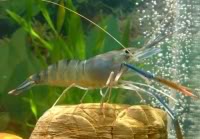 The macrobrachium rosenbergii is appealing to culture because of its rapid growth performance and ability to survive and grow in turbid water conditions. Ulang can tolerate moderate temperature and salinity changes, and can be caught in tributaries and cultured in ponds, tanks, cages, and rice paddies. They feed on anything such as terrestrial animal feeds, fish feeds, kitchen leftovers, and vegetables like carrots, winged beans, etc.
The macrobrachium rosenbergii is appealing to culture because of its rapid growth performance and ability to survive and grow in turbid water conditions. Ulang can tolerate moderate temperature and salinity changes, and can be caught in tributaries and cultured in ponds, tanks, cages, and rice paddies. They feed on anything such as terrestrial animal feeds, fish feeds, kitchen leftovers, and vegetables like carrots, winged beans, etc.
Freshwater prawn can be used in polyculture together with tilapia and carp. They can tolerate temperature up to 34oC and actively feed at night. They consumed less feed than tilapia since they are nibblers and slow feeder. They grow to a maximum size of more than 1 kilogram per piece and they command high price in the market.
GROW-OUT OPERATION OF ULANG
Factors affecting success of grow-out operation:
1. Feasibility of the site
2. Water Supply/Water Quality
3. Topography
4. Quality of soil
5. Free from flooding
6. Quality of Stock
7. Market acceptance
8. High level Management practices
9. Peace and order situation
I. PROCEDURES IN POND OPERATION:
Pond Preparation
1. Pond draining – To collect eliminate old stocks, predators and unwanted species.
2. Pond poisoning – Application of biodegradable organic materials such as tea seed cake and tobacco dust to kill all unwanted species.
3. Pond washing – to remove the effect of toxic chemicals when insecticides were used.
4. Leveling of pond bottom – removes excess mud and dirt, ensure complete drainage and facilitate ease of seining during harvesting.
5. Sun drying – helps eliminate and evaporates toxic gases & ammonia especially in old ponds
6. Screening of water inlet and outlet – prevent entrance of unwanted species and escape of stocks
7. Filling the pond with water –Fill the pond with water from 0.8 to 1.5 meters depth.
8. Application of lime– The rate of application is 100g / m2 or 1,000 kg./ ha
9. Basal fertilization
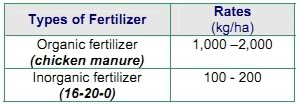
10. Installation of Artificial shelters – arrange the shelters in the pond (30 – 50 pcs/1000m2)
II. NURSING OF POST LARVAE (PL) TO JUVENILE
Nursing of PL to Juvenile Prawn– The size of the Post larvae ranging from 1.5 to 2.0 cm must be reared to juvenile size of 5 cm to 8 cm before transferring them into the grow-out ponds to attain marketable size.
a. Nursery Ponds. The size of the pond must be 50 sq.m. with a depth; 0.8-1.5 m
b. Artificial shelters. This are placed in the nursery ponds to serve as hiding place of the Post larvae during molting. Artificial shelter is needed because when prawns are soft shelled they will be eaten or cannibalized by the hard shells prawn. The following can be used as artificial shelters:
1. twigs, bamboos , sampaloc twigs
2. pipes, PVC, or recycled materials like nets
3. bricks or stones
4. used mineral water bottles (250-300 ml)
c. Nets used for substrate can be suspended from float across the pond and weighted with sinkers to serve as hiding place for molting prawns to prevent or reduce cannibalism.
III. GROWING OF JUVENILE TO MARKETABLE SIZE
Stocking Density
Extensive – The stocking density is 1-3 pcs/m2, with the use of fertilization only (chicken manure and 16-20-0) at a rate of 1,000-2,000 kg/ha and 100-200 kg/ha respectively for basal application.
Semi- intensive – A stocking density of 4-8 pcs/m2 with the use of fertilization and feeding. A monthly exchange of 30% of water in the pond is done to maintain water quality
Intensive – The stocking density of 10 pcs /m2 and above with feeding, fertilization, frequent water exchange and aeration using paddle wheel is also done to ensure enough supply of dissolve oxygen for the prawn.
Stocking Procedure
Acclimatize the prawn juveniles into the pond water for 10-15 min. before releasing the prawn in the pond water to prevent thermal stress that will cause mortality.
CAUSES OF MORTALITY:
a. Cannibalism- due to lack of food and shelters
b. Predators – mudfish, catfish, frogs
c. Water pollution – insecticide, pesticide, industrial waste products
Types of Feeds for Commercial Farming of Ulang
1. Live or fresh food (termites, earthworm, insects
2. Plant vegetable feedstuffs
3. Formulated diets
4. Reformulated diets (ground tilapia feeds mixed with fish meal & starch as binder)
5. Chicken pellets (to be given during the first 2 mos. of culture)
6. Ground fish flesh mixed with cooked broken rice (to be given after two mos. of stocking)
7. Tilapia sinking pellets
8. Trash fish
Initial feeding rate using trash fish:
• 5% of total body weight
For dried diet, chicken pellets/fish feed:
• 3% of total body weight
• prawn are nocturnal feeder 40 % of feed ration must be given at night.
Regular water quality monitoring and feeding activities of the prawn must be properly observed.
DETERMINATION OF AVERAGE BODY WEIGHT (ABW), DAILY FEED RATION (DFR), TOTAL FEED REQUIREMENTS (TFR) FEED CONVERSION RATIO (FCR)
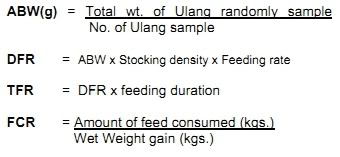
* The closer the FCR to 1.0 kg. The better is the feeds. Good feed have FCR’s of between 1.5 to 2.0 kgs.
HARVESTING OF ULANG
Harvesting of ulang can be done when they reached its marketable size. After 4to 5 months of stocking, ulang can be harvested through selective harvesting or total harvesting.
Methods of harvesting
1. Selective – this is done by seining the prawns using size 17 net. The bottom of the seine net should be kept intact on the pond bottom to avoid escape of the prawn.
2. Total harvesting – this is done by total draining of the pond. The prawns can be collected in the catch basin manually by using scoop net or with bare hands.
Marketable Sizes of Prawn After 4 To 5 Months Culture
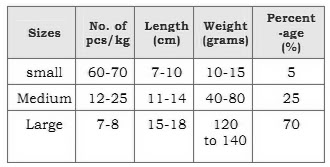
Measurement of length is from tip of the rostrum to end of the telson
Simple Cost Estimate
(1,000 sqm Ulang Fishpond Project)
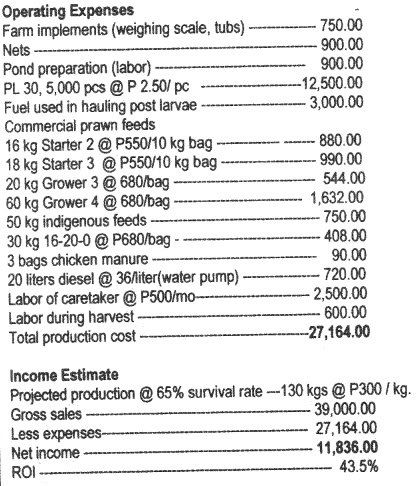
For more information please call or write to:
The Project Manager
BFAR-NFFTC
CLSU, Muñoz, Nueva Ecija
Tel No. (044) 4560-671 to 72
Fax no. (044) 4560-671
E-mail address:[email protected]
Source: NFFTC Technology and Information Services DA-BFAR
Photo: itsnature.org


How is the tank set up for fresh water prawns..is it possible like that of backyard tilapia?
mayron po bang nagcuculture ng macrobrachium rosenbergii sa palawan, at saan po ba sa palawan.?
am in palawan, how can I get the fingerlings of this giant fresh water prawns. pls advise how because it can hellp us in our family economy. contact me. 09283131134